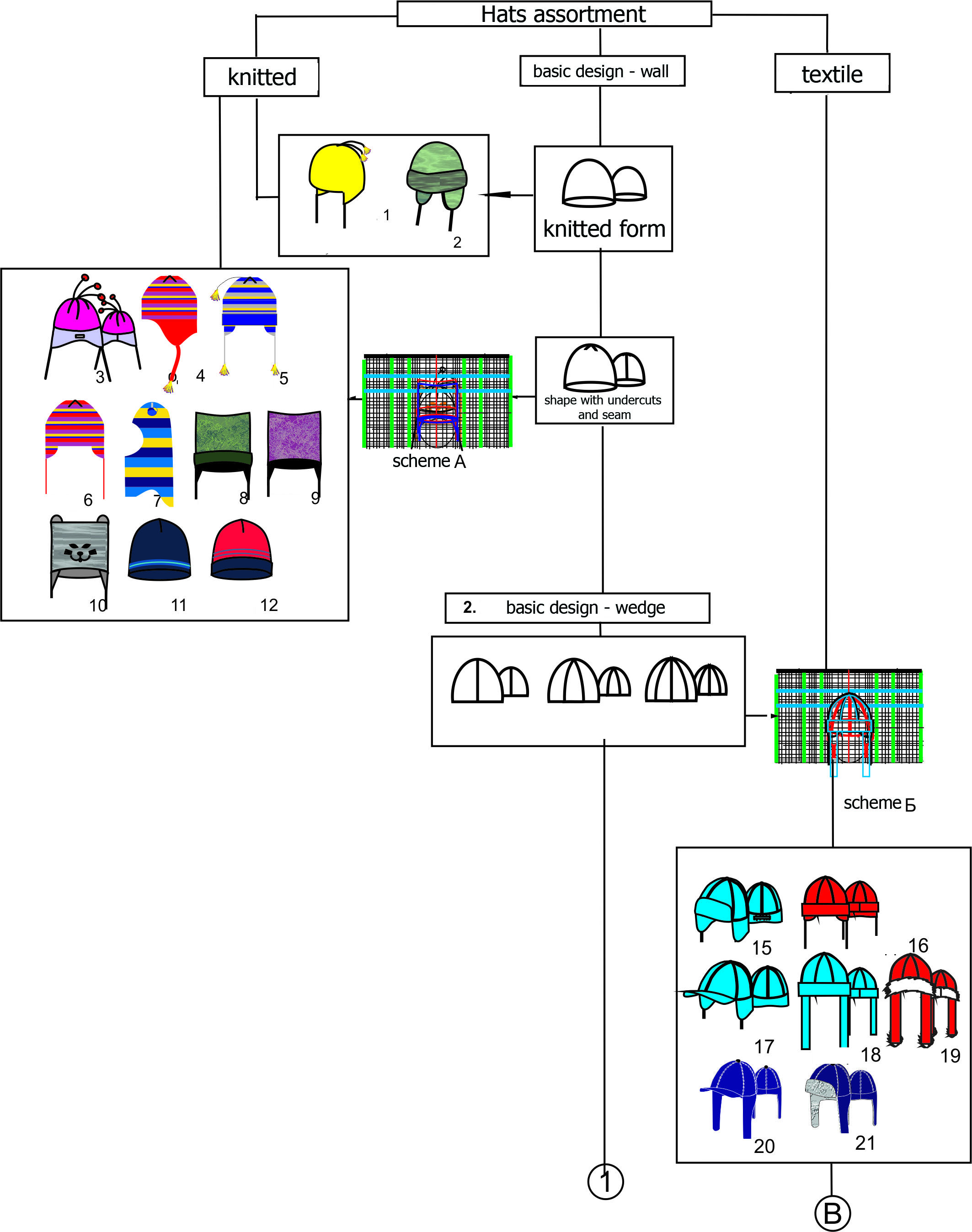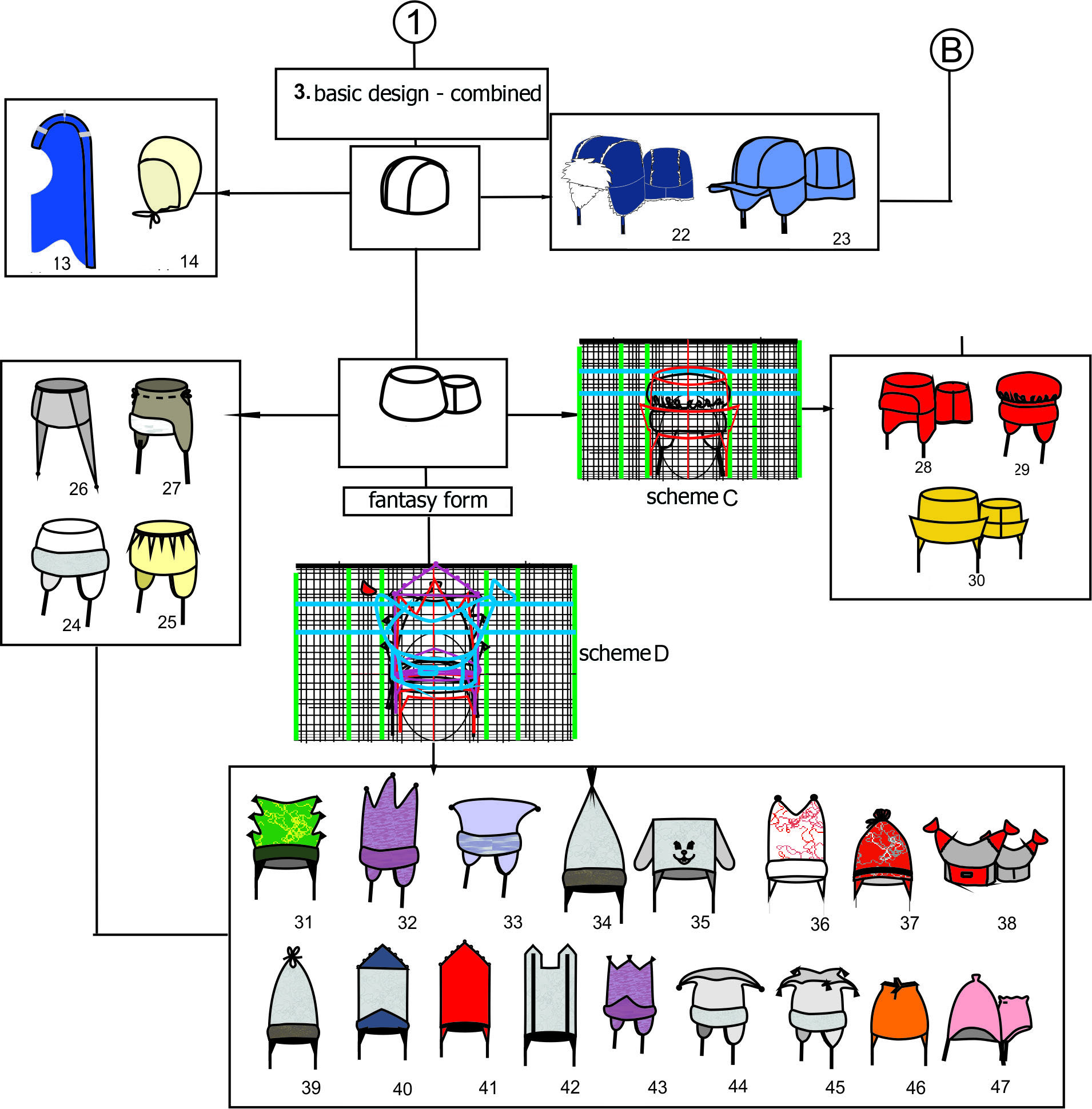Abstract
The article is theoretical and applied in nature and is the result of a study and analysis of the use of digital technologies in the field of design (for example, the design of hats). The problem of digital design of new products and the formation of an assortment of hats taking into account fashion trends and consumer demand is being raised. Since in the market conditions of managing the competitiveness of products, their conformity with fashion and consumer demands is a necessary attribute that allows them to withstand competition and ensure the company's profit, the search for new ideas and styles for the development of new products, expanding the product range and ensuring the quality of designed hats is especially significant . Moreover, the listed functions must be implemented using modern digital technologies that reduce design time and take into account as many factors as possible market and consumer factors. The design of new products and the formation of an assortment of hats based on the methodology developed by the authors using marketing and digital design technologies allows us to expand the boundaries of digital technologies and improve the range of hats. The conducted studies prove the hypothesis of the effectiveness of the use of digital technologies based on the use of existing software products and their combination.
Keywords: Designdigital technologymarketing researchdesign of new productsassortment formationhats
Introduction
The effective design of new products and the formation of an assortment of hats in a competitive market is one of the important areas of activity of clothing manufacturers, including hats. The use of digital technology in the design of hats, the application of methods to improve the range and improve the quality and competitiveness of products, is relevant today.


Problem Statement
Due to the fact that the search for new ideas and styles for the development of new products, expanding the product range and ensuring the quality of designed hats is especially significant for mass production, the authors formulated a hypothesis on the effectiveness of the use of digital technologies that would integrate research in the field of fashion, design (shaping), meeting demand and the formation of an assortment of products. In modern conditions, it is necessary to use methods that allow you to search for relevant and fashionable ideas and design competitive products that allow you to increase the income of enterprises. Advances in digital technology can solve these problems. Designing novelty products and a range of hats based on the methodology proposed by the authors using marketing technologies and digital design allows us to expand the boundaries of digital technologies, improve the range of hats, and reduce the time for product design and development.
Research Questions
Improved methods of projection of holes in the position of applications of digital technology to the disadvantaged object (Korobtseva & Nesteruk, 2014; Kudryashova, Denisova, & Pogorelova, 2009; Lutskova, 2009) and jewelry professionals (Huaixiang, 2007; Ball, 2014). The issues of improving the design process of hats based on a three-dimensional scanning design, designing hats in the AutoCAD graphics editor, designing hats using architectonics in 3-D format are presented in the works of Russian scientists (Petrosova, Guseva, & Lopasova, 2013; Shakhmatova, Vlasova, & Sudarushkina, 2016).
The design issues of hats based on combinatorial shaping were also raised in the works of specialists from Russia (Chulkova, 2009). Similar studies in the field of design in the field of light industry and culture, digital design technologies are carried out by foreign authors (Hayes, & McLoughlin, 2008; Loy, Canning, & Little, 2015; Moon, 2018; Lee et al., 2018).
The study of the problems of the formation of product strategies and digital design design from the standpoint of economics and marketing, the introduction of innovations in light industry are also the subject of research by Russian and foreign scientists (Bank, Vilisov, & Khristoforova, 2016; Maldini, Stappers, Gimeno-Martinez, & Daanen, 2019).
Purpose of the Study
The main objective of the study, the results of which are presented by the authors in this publication, is to develop and implement digital methods in modern design that allow you to take into account fashion trends and marketing aspects, in particular, customer satisfaction.
Research Methods
As methods of obtaining secondary information during desk research, the authors of the article used: goal-setting, grouping, ranking of product elements (form, style, materials, time). To create a database on this set of criteria, specialized publications were used – magazines and fashion catalogs, which included: Vogue, Officiel, Jardin des Modes, Linea Italiana, Les modes, L art et la mode published over the period from the beginning of the last century to present (from 1905 to 2017). Observation periods, the frequency of occurrence of forms, sizes and materials were recorded and entered into the program for statistical processing of Excel data, and the characteristics of forms and styles were recorded in one of the most popular vector graphics editor Adobe Illustrator among practicing designers.
Findings
The main stages of designing hats include: research, search, analysis of options and design (figure
During the design process, computer technologies recommended for use provide the opportunity to transform the shape of the headgear and its parts (fields, tulas, peaks, etc.), determining the design of the products while searching for the formation zones. In addition, there is the formation of a product range across the entire line of designed products. In the figure
Conclusion
The conducted studies prove the hypothesis of the effectiveness of the use of digital technologies based on the use of existing software products and their combination. The author's classification of headgear shaping by assortment and the use of a headwear proportioning matrix optimizes the fulfillment of tasks.
References
- Ball, R. (2014). 15-Headwear: Designing headwear to fit the size and shape of Western and Asian populations. In M.-E. Faust, S. Carrier (Eds.), Designing Apparel for Consumers: The impact of body shape and size. Woodhead Publishing Series in Textiles (pp. 292-307). Cambridge: Woodhead Publishing. https://doi.org/10.1533/9781782422150.2.292
- Bank, S. V., Vilisov, V. Ya., & Khristoforova, I. V. (2016). Formation of innovative product strategy in terms of import substitution. Questions of the Regional Economy, 1(26), 3-7. [in Rus.].
- Chulkova, E. N. (2009). Features application of the method of combinatorial shaping the design headgear. Design and Technology, 12(54), 14-21. [in Rus.].
- Hayes, S. G., & McLoughlin, J. (2008). 10-Technological advances in sewing garments. In C. Fairhurst (Ed.), Advances in Apparel Production. Woodhead Publishing Series in Textiles (pp. 197-221). Cambridge: Woodhead Publishing. https://doi.org/10.1533/9781845694463.2.197
- Huaixiang, T. (2007). Variety hats (chapter 8). In T. Huaxiang (Ed.), Costume Craftwork on a Budget: Clothing, 3-D Makeup, Wigs, Millinery & Accessories (pp. 137-163). Burlington, MA: Focal Press. https://doi.org/10.1016/B978-0-240-80853-6.50013-4
- Korobtseva, N. A., & Nesteruk, I. V. (2014). Individual style as a component of the image design of hats. Monograph. Moscow: Moscow State University of Design and Technology. [in Rus.].
- Kudryashova, D. A., Denisova, O. I., & Pogorelova, M. L. (2009). Designing children's hats using marketing research. Scientific Bulletin of the Kostroma State Technological University, 2, 19. [in Rus.].
- Lee, W., Lee, B., Yang, X., Jung, H., Bok, I., Kim, C., ... & You, H. (2018). A 3D anthropometric sizing analysis system based on North American CAESAR 3D scan data for design of head wearable products. Computers & Industrial Engineering, 117, 121-130. https://doi.org/10.1016/j.cie.2018.01.023
- Loy, J., Canning, S., & Little, C. (2015). Industrial design digital technology. Procedia Technology, 20, 32-38. https://doi.org/10.1016/j.protcy.2015.07.007
- Lutskova, L. V. (2009). Improving the methods of industrial design of hats. Ph.D. Thesis. Moscow: Moscow State University of Design and Technology. [in Rus.].
- Maldini, I., Stappers, P. J., Gimeno-Martinez, J. C., & Daanen, H. A. M. (2019). Assessing the impact of design strategies on clothing lifetimes, usage and volumes: The case of product personalization. Journal of Cleaner Production, 210, 1414-1424. https://doi.org/10.1016/j.jclepro.2018.11.056
- Moon, G. (2018). Conflict colors. Design and Culture: The Journal of the Design Studies Forum, 10(3), 369-377. https://doi.org/10.1080/17547075.2018.1509557
- Petrosova, I. A., Guseva, M. A., & Lopasova, L. V. (2013). Preparation of initial information and design of haddresses in three-dimensional SAPR. Design and Technology, 36(78), 42-47. [in Rus.].
- Shakhmatova, Yu. D., Vlasova, Yu. S., & Sudarushkina, E. S. (2016). Search for 3-D forms in the development of hats using architectonics methods. In O.V. Kascheev, O.S. Oleneva. Yu.V. Vinogradova, I.V. Rybaulina, K.E. Razumeev, & et al. (Eds.), Proceedings of the All-Russian Scientific Student Conference “Innovative development of light and textile industry” (INTEX-2016) (pp. 26-28). Moscow: Moscow State University of Design and Technology. [in Rus.].
Copyright information

This work is licensed under a Creative Commons Attribution-NonCommercial-NoDerivatives 4.0 International License.
About this article
Publication Date
09 March 2020
Article Doi
eBook ISBN
978-1-80296-078-5
Publisher
European Publisher
Volume
79
Print ISBN (optional)
-
Edition Number
1st Edition
Pages
1-1576
Subjects
Business, business ethics, social responsibility, innovation, ethical issues, scientific developments, technological developments
Cite this article as:
Khristoforova*, I. V., Demenkova, A. B., & Arkhipova, T. N. (2020). Digital Technologies In The Design Field: From Marketing Research To Product Development. In S. I. Ashmarina, & V. V. Mantulenko (Eds.), Global Challenges and Prospects of the Modern Economic Development, vol 79. European Proceedings of Social and Behavioural Sciences (pp. 877-881). European Publisher. https://doi.org/10.15405/epsbs.2020.03.126
